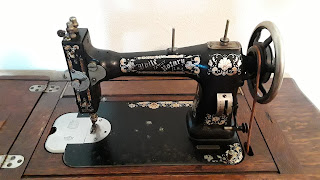One day, I mentioned to my husband that I'd always wanted a treadle or hand crank sewing machine...a few weeks later, this White Rotary treadle entered the house. He found it at an antique show. Its cabinet needed some minor repairs - one of the drawers was in really bad shape and the others were loose. A good friend of ours who is a wood worker made a replacement piece for the broken drawer and fixed up the rigging holding the drawers on.
Dating this machine is a little bit confusing. It's possible that certain parts of this machine are not original pieces. According to the "White Sewing Machine Background and Model Guide", Serial Number FR 258130 was made in 1880-1883.
The needle plate, however, lists patents from 1890 - 1905 (with additional patents pending).
Given the condition of the machine bed, which appears to have been repainted (you can still see some divots in it indicating that some paint was applied to cover rusted spots, but wasn't applied as thickly as the original paint), I suspect that the original needle plate may have been lost and was replaced using a newer one which was in decent condition.
Let's take a tour of this fine treadle specimen!
Closed view of the cabinet. I'm so glad I had a friend who is a woodworker who was able to patch up the drawers. They were nearly falling off when I got the machine.
Extension board half lifted. You can see the wire that pulls the machine up from its resting place. I have the treadle belt pulled off of the pulley to keep tension off of it while the machine is down.
Open and ready to sew. You should notice that the board in the center front of the cabinet flips up inside when the machine is raised in sewing position. When the machine is down, that board in center front hides the machine from view, but when open it flips out of the way to provide more knee room under the cabinet.
The lovely girl all ready to sew... just add thread and fabric.
Right side view showing treadle belt and wheel.
Back view. It's missing some decals in various spots, and you can see how the black is uneven, indicating that someone painted over a bunch of rusty spots on the machine.
Birds' eye view of the machine. I love the way the cabinet is constructed to automatically set up the machine as soon as the extension board is lifted.
Close up of the bobbin winder and stitch length adjuster.
Left side view of machine. I love the decals on this. It's too bad may of them are rubbed off.
A peek at the bobbin case underneath the needle plate.
The bobbin case pulled out for examination. Interesting "handle" on outside of bobbin case.
Box of attachments in one drawer
I believe this set of attachments is complete. Above is a view of the top half of the attachment box showing a collection of different size hemmers.
The main compartment of the accessories box. It has a few tools in there as well as additional feet.
I pulled these three out of the case for the earlier photo because they covered over a bunch of other feet in the case. Glad to see it has a ruffler and ribbon guide.
A Picoting attachment!!! Fun little gadget. I will have to try it out some day.
This is clearly something purchased at a much later time than the original machine. I probably should put it in my Singer 401A's cabinet since it's a Singer item and not a White item (though you can obviously use this on any machine)
This is the Singercraft that was in the package.
I have read about these, and this one isn't very special. I think it was made back in the 1950s. It's still a neat gadget to have. Perhaps some day I'll experiment with it.
And that's it for now!
HAPPY SEWING.


























i just was gifted a machine very similar to yours - both machine head and cabinet. After getting a new belt and giving it a thorough cleaning I’m still not able to sew with it. The treadle works smoothly, the needle goes up and down smoothly, but I can not get the needle to pick up the bobbin thread. Any suggestions?
ReplyDeleteGood question! First, check that you have inserted the needle facing the right way and that you have threaded it correctly. Do you have a White Rotary flat shank needle in it? The needles are slightly longer (http://ismacs.net/needle_and_shank/needle-cross-reference-charts.html) than standard Singer needles. Next, double-check that you've inserted the bobbin facing the right way and have the thread properly placed in the grooves. Instructions on Page 5 of the manual: http://ismacs.net/white/manuals/white-rotary.pdf
Delete